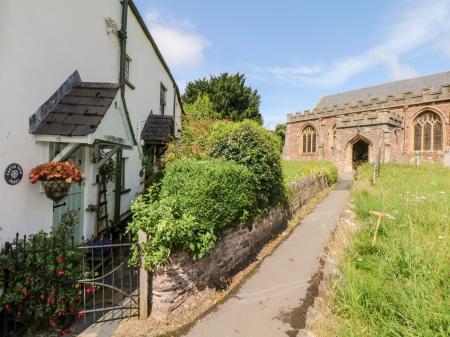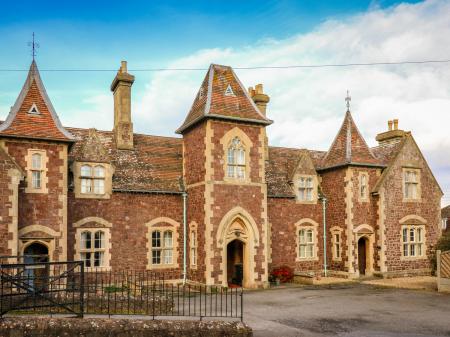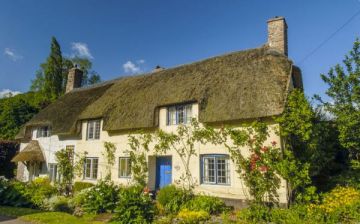
The mill features a pair of overshot wheels to the east side, and the interior milling machinery is in full working order. The use of two overshot wheels is quite unusual. The mill site is entered through a large gatehouse with a pointed arch and wrought-iron gates.
The overshot wheels power the grindstones by a series of belts linked to the crown wheel. This drives the grindstones themselves and the sack lift. On the first floor is a doorway allowing corn to be lifted to the top of the mill building. The milled grain is then sifted through a winnowing machine. You can buy freshly ground wholemeal organic flour in the mill or at the Dunster Castle shop.
The mill leat is drawn from the river Avill, which rises high on Exmoor and guarantees a steady flow in both dry and wet seasons. It runs from the foot of Grabbist Hill, under a bridge on Tiverton Road, then directly under Park Lane and Mill Lane to emerge at the foot of Castle Hill where the mill is located.
It then rejoins the river just beyond Lover's Bridge, immediately to the east of the mill. It is fun to try to trace the course of the leat as it runs beneath buildings and streets on the western edge of Dunster.
History
A Saxon mill existed in this location at least as early as 1066. Twenty years later, the Domesday Book mentions a pair of grist mills at Dunster, known as Castle Mill and Nethermylle. By 1279 the two mills returned an annual revenue of some 2 pounds 13s 4d. In 1329 Sir John de Mohun of Dunster Castle leased his two mills to Walter Rughe, one of Dunster's burgesses, for 24 marks.
In 1405 Sir Hugh Luttrell leased both mills for a term of 60 years at a yearly rent of 10 pounds, on the condition that the tenants would handle any repairs, though Sir Hugh agreed to supply the timber for those repairs.
In 1427 a third mill called Newmylle (Newmill) was built beside Nethermylle by a tenant named William Person. Within 4 years the mills were renamed as Overmylle, Nethermylle, and Newmylle.
In 1604 George Luttrell engaged in a dispute over the legality of diverting the millstream. Just a few years later in 1620, the mils were renamed yet again; the first was now called Higher Mill, while the other two mills were combined under one roof to become Lower Mill.
The Higher Mill was last mentioned in 1650 though we do not know exactly when it was demolished or, indeed, where it stood. That left only the Lower Mill, with two mill wheels. A curious note in the 17th-century records suggests that the miller, one Ralph Hill, invested his profits from the mill in a set of 6 silver spoons.

In 1779 the mill was rebuilt and new milling machinery installed. This gave the mill its present appearance. The mill was leased to John Harvey and the Harvey family continued to run it until 1875 when their family business was taken over by Thomas Evered. It passed in time to James Phillips, but Phillips had another mill at Minehead and, as Sir Maxwell Lyte remarked in his diary for 1909, 'The wheels often stand idle nowadays...'
Sometime in the late 19th or early 20th century the mill was adapted to allow one waterwheel to drive two sets of grindstones. Only one set of stones was used for producing wheat flour. The old wooden machinery was replaced with cast iron, with the exception of the waterwheels.
In 1930 the mill was run by the Cockrem brothers who ground flour just once a week and baked fresh rolls for delivery to the Castle and throughout the village. It became a popular subject for artists, drawn by its romantic situation on the millstream and the covering of ivy that clung to the mill exterior. So popular did the mill become that the castle charged painters 2/6d per day for sketching or painting.
The mill was restored in 1939 and continued to grind grain for animal feed until 1962. The National Trust restored it to full working order in 1979 and it opened to the public in 1980.
Visiting
The mill can be reached through Dunster village by following Mill Lane, or from the Dunster Castle riverside walk. The walk is very well signposted from within the castle grounds.
We were lucky to arrive just as a mill volunteer was about to open the sluice-gate controlling water flow to the millwheels. He showed us how they maintain the water flow and we watched as the millwheels slowly gathered speed under the onrushing water. It was fascinating to see a process that has not changed in hundreds of years.
We also got to watch the miller grinding and bagging flour and tour the upper floors of the mill where grain is fed into the grinding wheels from above.








 We've 'tagged' this attraction information to help you find related historic attractions and learn more about major time periods mentioned.
We've 'tagged' this attraction information to help you find related historic attractions and learn more about major time periods mentioned.


